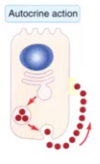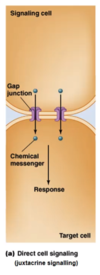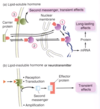Animal - Section A - Chemical Signaling 1 Flashcards
There are three types of chemical communiction?
Name the three types and give an example of each.
Intra cellular (within cells)
- intracellular messenger chemicals
- intracellular messengers relay information from cell surface receptors to activate appropriate cellular response
Inter cellular (between cells)
- short range e.g. neurotransmitters e.g. acetylcholine
- long range e.g. hormones e.g. testosterone
-Inter organismal (between organisms e.g. pheromones and allelochemicals)
- short range e.g. alarm, recognition, courtship
- long range e.g. territory markers, sex attractants
Describe secondary messengers within cells
(Acetylcholine)
When action potential gets to synaptic end, it stimulates the opening of voltage gated calcium channels and calcium moves into the cell which then tells the synaptic vessicles containing acetylcholine to move to the membrane to be released.
(Calcium ion acting as an intracellular messenger chemical)
Intercellular signalling
(Outside the cell into the extra cellular space)
Explain Juxtacrine signalling
- Adjacent cells by direct contact
- One cell to another without ever leaving the cells into the ECS
1. Cells conected by pours
(When they produce a messenger cell on one cell they can actually feed straight through the pours snd into the adjacent cell without ever coming out into the ECS)
2. Not signalling
Two cells:
One cell has a receptor molecule expressed on the outside of the cell and it connects directly to a receptor on the adjacent cell without actually being released as a free molecule.
Intercellular signalling
(Outside the cell into the extra cellular space)
Explain autocrine cells
Cells which can release chemicals into the ECS which can bind to receptors on the same cell possibly to reduce the release of further chemicals via a negative feedback mechanism.

Intercellular signalling
(Outside the cell into the extra cellular space)
Explain Paracrine signalling
Release messenger chemicals which affect nearby cells
(target cell likely to be the same cell type type as the one that releases it because its the same cell in the same tissue)

Intercellular signalling
(Outside the cell into the extra cellular space)
Explain Endocrine/neuroendocrine signalling?
*endochronologist
Releases substances into the blood stream and diffuses into the blood and it affects cells in a completely different part of the body
(hormones)
Target cell likely to be completely different tissue types e.g.
The gonads releasing sex steroid hormones such as Testosterone and Estradiol and how they flood out into the blood stream and how they’re effecting target cells that will have an effect on:
- Neurons in the brain
- Gonadal tissue
- Testosterone stimulating the growth of skeletal muscle and bone
- Secondary sexual characteristics like growth of facial hair.

Explain pheromonal intercellular signalling

Draw a basic Direct cell signalling diagram
(juxtacrine)
be sure to include
- signalling cell
- gap junction
- chemical messenger
- response
- target cell

Draw a basic diagram of the below
(Autocrine and paracrine signalling)
Be sure to include the following
- Signalling cell
- Response
- Chemical messenger
- Signal transduction
- Receptors
- Signal transduction
- Response
- Target cell

Draw a basic diagram of Endocrine signalling
Be sure to include the following:
- Signalling cell
- Circulatory system
- Chemical messenger
- Receptor
- Signal transduction
- Response
- Target Cell

Draw a Neural signalling diagram
Be sure to include the following:
- Signalling cell
- Electrical signal
- Chemical messenger (neurotransmitter)
- Receptor
- Signal transduction
- Response
- Target cell

Draw 3 different types of ligand (chemical) receptors in animals

What is a Ligand?
A chemical receptor in animals
Describe briefly how these three ligands function:
-Ligand gates ion channel
-Receptor enzyme
-G Protein / coupled receptor
Ligand gates ion channel
Ion channel is connected to the ligan binding site
Receptor enzyme
G Protein / coupled receptor
When the ligan binds to the protein it causes a structual change to the protein
Give an example of the following:
-Neutotransmitter
-Cytokines
-Growth factors
-Hormones
Neurotransmitter
-Highly variable chemically (NO - vaso dilation)
(Neuropeptides - act between electrically exciteable cells via paracrine signalling - can also work through autocrine signalling to modulate neuron activity)
Cytokines
Generally peptides, proteins.
They can be involved in all types of cellular signalling from juxtacrine right through to endocrine signalling
Growth factors
Are just a class of cytokine that specifically stimulate growth preliferation or cellular differentiation in tissues.
(Human HCG aka Human chorionic gonadotropin steroid in sports, stimulates skeletal muscle growth, if you take it it increases muscle size ans strength)
Death Cells
Class of Cytokine which stimulates cell death (apoptosis)
Hormones
Highly chemically variable
Simple small molecular weight chemicals such as Adrenaline
through to heavier molecules such as
Steroids (testostorone) to really large m weight peptides
(Insulin a large molecular weight peptide hormone)





